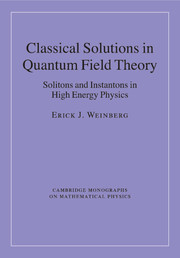Description
Classical Solutions in Quantum Field Theory
Solitons and Instantons in High Energy Physics
Cambridge Monographs on Mathematical Physics Series
Author: Weinberg Erick J.
An overview of classical solutions and their consequences in quantum field theory, high energy physics and cosmology for graduates and researchers.
Language: English
Subjects for Classical Solutions in Quantum Field Theory:
Classical Solutions in Quantum Field Theory
Publication date: 02-2015
Support: Print on demand
Publication date: 02-2015
Support: Print on demand
Approximative price 110.37 €
In Print (Delivery period: 14 days).
Add to cart
Classical solutions in quantum field theory: solitons and instantons in high energy physics
Publication date: 08-2012
342 p. · 17x24.4 cm · Hardback
Publication date: 08-2012
342 p. · 17x24.4 cm · Hardback
Description
/li>Contents
/li>Biography
/li>
Classical solutions play an important role in quantum field theory, high-energy physics and cosmology. Real-time soliton solutions give rise to particles, such as magnetic monopoles, and extended structures, such as domain walls and cosmic strings, that have implications for early universe cosmology. Imaginary-time Euclidean instantons are responsible for important nonperturbative effects, while Euclidean bounce solutions govern transitions between metastable states. Written for advanced graduate students and researchers in elementary particle physics, cosmology and related fields, this book brings the reader up to the level of current research in the field. The first half of the book discusses the most important classes of solitons: kinks, vortices and magnetic monopoles. The cosmological and observational constraints on these are covered, as are more formal aspects, including BPS solitons and their connection with supersymmetry. The second half is devoted to Euclidean solutions, with particular emphasis on Yang?Mills instantons and on bounce solutions.
1. Introduction; 2. One-dimensional solitons; 3. Solitons in more dimensions - vortices and strings; 4. Some topology; 5. Magnetic monopoles with U(1) charges; 6. Magnetic monopoles in larger gauge groups; 7. Cosmological implications and experimental bounds; 8. BPS solitons, supersymmetry, and duality; 9. Euclidean solutions; 10. Yang–Mills instantons; 11. Instantons, fermions, and physical consequences; 12. Vacuum decay; Appendixes; References; Index.
Erick J. Weinberg is Professor of Physics in the Department of Physics, Columbia University. Since 1996 he has been Editor of Physical Review D. His research interests include the implications of solitons and instantons for high-energy physics, cosmology and black holes, as well as a variety of other topics in quantum field theory.
© 2024 LAVOISIER S.A.S.

